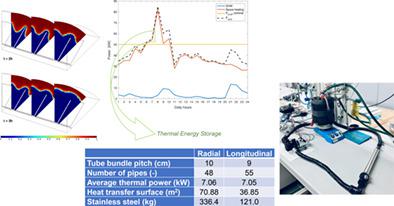当前位置:
X-MOL 学术
›
Int. J. Energy Res.
›
论文详情
Our official English website, www.x-mol.net, welcomes your
feedback! (Note: you will need to create a separate account there.)
Experimental and model validation of a phase change material heat exchanger integrated into a real building
International Journal of Energy Research ( IF 4.3 ) Pub Date : 2021-07-16 , DOI: 10.1002/er.7037 Gabriele Triscari 1 , Michele Santovito 2 , Maurizio Bressan 1 , Davide Papurello 1, 3
International Journal of Energy Research ( IF 4.3 ) Pub Date : 2021-07-16 , DOI: 10.1002/er.7037 Gabriele Triscari 1 , Michele Santovito 2 , Maurizio Bressan 1 , Davide Papurello 1, 3
Affiliation

|
Latent heat thermal energy storages (LHTES) are a promising technology with a wide range of applications in the framework of energy efficiency improvement. Phase change materials provide a big storage capacity, but their thermal conductivities are always extremely low. The use of finned tube heat exchangers is nowadays the best solution to enhance PCMs thermal performances. This allows significant charging and discharging rates. The major challenge concerns the balance between thermal performances and high material costs. A proper design of the heat transfer surfaces is essential to limit the system overall cost. Two different heat exchangers solutions, with radial and longitudinal fins are here examined. The design of the LHTES is performed by deploying a simplified FEM numerical model specifically developed for the application. A validation procedure based on laboratory tests with a small LHTES prototype was also carried out. The obtained results confirmed the reliability of the numerical model and justify its adoption as a tool for the design phase. The FEM model allows to effectively simulate the system thermal behaviour and assess the impact of the different HEX geometrical parameters on thermal performances. Based on this information it was possible to perform the optimization of the heat transfer surfaces and to derive the best heat exchanger layout in terms of material usage. The results showed that the solution with longitudinal fins is the most efficient, with 215 kg of steel less required for the realization of the finned heat exchanger.
中文翻译:

集成到真实建筑中的相变材料换热器的实验和模型验证
潜热热能储存(LHTES)是一种很有前途的技术,在提高能源效率的框架中具有广泛的应用。相变材料提供了很大的存储容量,但它们的热导率总是极低。翅片管换热器的使用是当今提高 PCM 热性能的最佳解决方案。这允许显着的充电和放电速率。主要挑战涉及热性能和高材料成本之间的平衡。传热表面的适当设计对于限制系统总成本至关重要。这里检查了两种不同的热交换器解决方案,带有径向和纵向翅片。LHTES 的设计是通过部署专门为应用程序开发的简化 FEM 数值模型来执行的。还使用小型 LHTES 原型进行了基于实验室测试的验证程序。获得的结果证实了数值模型的可靠性,并证明将其作为设计阶段的工具是合理的。FEM 模型允许有效地模拟系统热行为并评估不同 HEX 几何参数对热性能的影响。基于此信息,可以优化传热表面并根据材料使用得出最佳换热器布局。结果表明,采用纵向翅片的解决方案是最有效的,实现翅片式换热器所需的钢材减少了 215 公斤。获得的结果证实了数值模型的可靠性,并证明将其作为设计阶段的工具是合理的。FEM 模型允许有效地模拟系统热行为并评估不同 HEX 几何参数对热性能的影响。基于此信息,可以优化传热表面并根据材料使用得出最佳换热器布局。结果表明,采用纵向翅片的解决方案是最有效的,实现翅片式换热器所需的钢材减少了 215 公斤。获得的结果证实了数值模型的可靠性,并证明将其作为设计阶段的工具是合理的。FEM 模型允许有效地模拟系统热行为并评估不同 HEX 几何参数对热性能的影响。基于此信息,可以优化传热表面并根据材料使用得出最佳换热器布局。结果表明,采用纵向翅片的解决方案是最有效的,实现翅片式换热器所需的钢材减少了 215 公斤。FEM 模型允许有效地模拟系统热行为并评估不同 HEX 几何参数对热性能的影响。基于此信息,可以优化传热表面并根据材料使用得出最佳换热器布局。结果表明,采用纵向翅片的解决方案是最有效的,实现翅片式换热器所需的钢材减少了 215 公斤。FEM 模型允许有效地模拟系统热行为并评估不同 HEX 几何参数对热性能的影响。基于此信息,可以优化传热表面并根据材料使用得出最佳换热器布局。结果表明,采用纵向翅片的解决方案是最有效的,实现翅片式换热器所需的钢材减少了 215 公斤。
更新日期:2021-09-09
中文翻译:

集成到真实建筑中的相变材料换热器的实验和模型验证
潜热热能储存(LHTES)是一种很有前途的技术,在提高能源效率的框架中具有广泛的应用。相变材料提供了很大的存储容量,但它们的热导率总是极低。翅片管换热器的使用是当今提高 PCM 热性能的最佳解决方案。这允许显着的充电和放电速率。主要挑战涉及热性能和高材料成本之间的平衡。传热表面的适当设计对于限制系统总成本至关重要。这里检查了两种不同的热交换器解决方案,带有径向和纵向翅片。LHTES 的设计是通过部署专门为应用程序开发的简化 FEM 数值模型来执行的。还使用小型 LHTES 原型进行了基于实验室测试的验证程序。获得的结果证实了数值模型的可靠性,并证明将其作为设计阶段的工具是合理的。FEM 模型允许有效地模拟系统热行为并评估不同 HEX 几何参数对热性能的影响。基于此信息,可以优化传热表面并根据材料使用得出最佳换热器布局。结果表明,采用纵向翅片的解决方案是最有效的,实现翅片式换热器所需的钢材减少了 215 公斤。获得的结果证实了数值模型的可靠性,并证明将其作为设计阶段的工具是合理的。FEM 模型允许有效地模拟系统热行为并评估不同 HEX 几何参数对热性能的影响。基于此信息,可以优化传热表面并根据材料使用得出最佳换热器布局。结果表明,采用纵向翅片的解决方案是最有效的,实现翅片式换热器所需的钢材减少了 215 公斤。获得的结果证实了数值模型的可靠性,并证明将其作为设计阶段的工具是合理的。FEM 模型允许有效地模拟系统热行为并评估不同 HEX 几何参数对热性能的影响。基于此信息,可以优化传热表面并根据材料使用得出最佳换热器布局。结果表明,采用纵向翅片的解决方案是最有效的,实现翅片式换热器所需的钢材减少了 215 公斤。FEM 模型允许有效地模拟系统热行为并评估不同 HEX 几何参数对热性能的影响。基于此信息,可以优化传热表面并根据材料使用得出最佳换热器布局。结果表明,采用纵向翅片的解决方案是最有效的,实现翅片式换热器所需的钢材减少了 215 公斤。FEM 模型允许有效地模拟系统热行为并评估不同 HEX 几何参数对热性能的影响。基于此信息,可以优化传热表面并根据材料使用得出最佳换热器布局。结果表明,采用纵向翅片的解决方案是最有效的,实现翅片式换热器所需的钢材减少了 215 公斤。











































 京公网安备 11010802027423号
京公网安备 11010802027423号